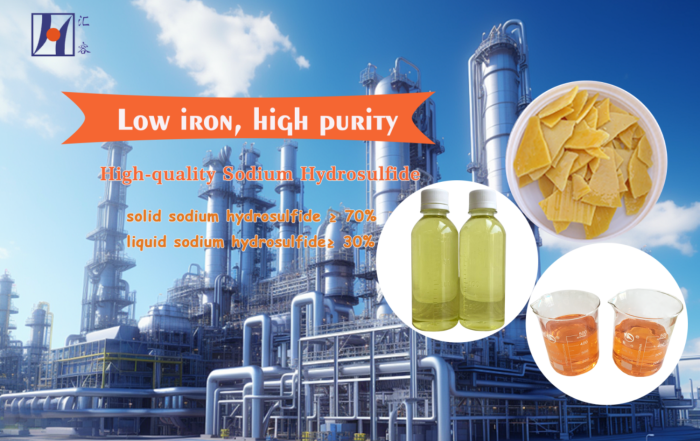Hydrogen sulfide (H₂S), a highly toxic gas with a rotten egg odor, once made people recoil in horror. Sodium hydrosulfide (NaHS), a seemingly ordinary white crystal, releases lethal gas when dissolved in water. Sodium sulfide (Na₂S), a strongly alkaline solid, can corrode skin and is used in dye production. These “three sulfur brothers,” though dangerous, play crucial roles in industry, medicine, and environmental protection. How did they transform from notorious poisons into indispensable chemical stars in modern technology? Let’s explore their fascinating journey.
01 The Chemical Identity of the Three Brothers
Sodium Hydrosulfide (NaHS): The product of the partial neutralization of H₂S with NaOH (H₂S + NaOH → NaHS + H₂O). Contains the HS⁻ ion, with a weakly alkaline aqueous solution.
Sodium Sulfide (Na₂S): The fully neutralized product of H₂S (H₂S + 2NaOH → Na₂S + 2H₂O). Contains the S²⁻ ion, strongly alkaline, and prone to deliquescence with H₂S release.
Hydrogen Sulfide (H₂S): The simplest sulfide, a polar molecule, weakly acidic, and highly soluble in water to form hydrosulfuric acid.
The Molecular Transformation of the “Sulfur Trio” from Gas to Solid
02 Chemical Transformations of the Three Brothers
NaHS to Na₂S: Achieved by adding excess NaOH or heating to dehydrate (2NaHS → Na₂S + H₂S↑).
Na₂S to NaHS: By bubbling H₂S gas through Na₂S (Na₂S + H₂S → 2NaHS).
H₂S Release: NaHS or Na₂S reacts with acids (e.g., HCl) to release H₂S (NaHS + HCl → NaCl + H₂S↑).
03 The Applications of the Three Brothers
1. Sodium Hydrosulfide (NaHS)
Sulfurizing Agent and Reducing Agent
Organic Synthesis: Produces thiols (e.g., methyl mercaptan, ethyl mercaptan) and thioethers for pesticides, pharmaceuticals, and fragrances.
Rubber Industry: Acts as a vulcanization accelerator to crosslink rubber molecules.
Metal Smelting: Used as a flotation agent to separate non-ferrous metals (e.g., copper, lead, zinc) and to recover precious metals (e.g., gold, silver) in hydrometallurgy.
– Leather Industry
Hair Removal Agent: Works with lime (Ca(OH)₂) to hydrolyze keratin in leather (strict control needed to prevent pollution).
Tanning Aid: Regulates pH to enhance the binding of tanning agents (e.g., chromium salts) to leather fibers.
– Wastewater Treatment
Heavy Metal Precipitation: Forms insoluble metal sulfides (e.g., CuS, PbS, HgS) to remove heavy metals (more effective than hydroxide precipitation).
Acidic Wastewater Neutralization: Neutralizes acidic wastewater while reducing toxic substances (e.g., Cr⁶⁺ to less toxic Cr³⁺).
– Chemical Production
Dyes and Pigments: Intermediate for sulfur dyes (e.g., sulfur black) and cadmium-based pigments (e.g., cadmium sulfide).
Paper Industry: Auxiliary agent in the kraft pulping process to break down lignin.
– Pharmaceutical Intermediates
Antibiotics and Vitamins: Key intermediate in the synthesis of sulfonamides and B vitamins (e.g., as a reducing agent or thiol protector).
Anticancer Drugs: Used to synthesize sulfur-containing heterocyclic structures (e.g., thiazole compounds).
– Other Applications
Oilfield Chemicals: Corrosion inhibitor or H₂S releaser in oil and gas extraction.
Laboratory Reagent: Source of HS⁻ ions for analytical or synthetic experiments.
2. Sodium Sulfide (Na₂S)
Chemical and Industrial Applications
Dye Production: Key raw material for sulfur dyes (e.g., sulfur black, sulfur blue) in textile dyeing.
Rubber Industry: Vulcanization accelerator to enhance rubber strength and elasticity.
Organic Intermediates: Synthesizes thiols and thioethers for pharmaceuticals and pesticides.
Non-Ferrous Metal Extraction: Precipitates metal sulfides (e.g., CuS, PbS) in hydrometallurgy.
Mineral Flotation: Improves the efficiency of metal ore (e.g., molybdenum, antimony) flotation.
– Leather Industry
Hair Removal Agent: Works with lime to decompose keratin in animal hides.
Tanning Aid: Regulates pH to enhance the binding of tanning agents (e.g., chromium salts).
– Environmental and Wastewater Treatment
Heavy Metal Removal: Reacts with heavy metals (e.g., Hg²⁺, Cd²⁺, Pb²⁺) to form insoluble sulfides.
Acidic Wastewater Neutralization: Neutralizes acidic wastewater while removing heavy metals.
– Other Applications
Paper Industry: Breaks down lignin in the kraft pulping process.
Photography: Component of traditional black-and-white photo developing solutions.
Laboratory Reagent: Reducing agent or sulfur source for chemical synthesis and analysis.
3. Hydrogen Sulfide (H₂S)
Industrial Chemical Raw Material
Sulfuric Acid Production: Converted to sulfur via the Claus process, then oxidized to SO₂ for sulfuric acid production.
Sulfur Recovery: Removes and recovers H₂S in petroleum refining and natural gas processing.
Organic Synthesis: Produces sulfides (e.g., sodium sulfide, thiols), pesticides, and pharmaceutical intermediates.
– Laboratory Analysis
Metal Ion Detection: Forms metal sulfide precipitates (e.g., PbS, CuS) for qualitative analysis.
Reducing Agent: Used in organic and inorganic synthesis.
– Medical and Biological Fields
Physiological Regulation: Endogenous H₂S acts as a gas signaling molecule, regulating vasodilation, anti-inflammatory responses, and neuroprotection.
Drug Development: H₂S donor drugs (e.g., NaHS derivatives) explored for treating hypertension and Alzheimer’s disease.
Semiconductor Processing: Used in depositing metal sulfide thin films in electronics.
04 The Crossover of Sulfides in Biology and Technology, and Their Unpredictable Nature
1. Sulfides and Future Technology
Lithium-Sulfur Batteries: Lithium sulfide (Li₂S) as a high-energy-density cathode material.
Quantum Dots: Lead sulfide (PbS) for infrared sensors and tumor photothermal therapy.
2. From Toxic Gas to Life Signaling Molecule
Endogenous Gas: H₂S is synthesized in the human body via CBS and CSE enzymes, regulating vasodilation and neuroprotection.
3. Drug Development
Controlled Release Donors: NaHS derivatives for treating hypertension and Alzheimer’s disease.
The Dark Side – Dangers and Control
- Hazards of NaHS and Na₂S: Release H₂S upon contact with moisture; must be stored away from acids.
- Environmental Challenges: Industrial sulfur recovery efficiency reaches 99.8%, but leaks still pose environmental threats.
- Lethality of H₂S: 100 ppm can be fatal, a leading cause of accidents in the oil and gas industry.
The transformation of these “three brothers” embodies the duality of chemistry—toxicity depends on dosage, and value is defined by application. From rotten eggs to life-saving drugs, from industrial waste to high-tech materials, their journey reflects humanity’s ingenuity in harnessing nature.




